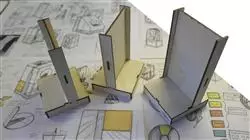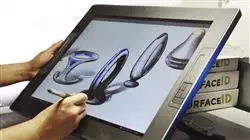University certificate
The world's largest faculty of design”
Introduction to the Program
This program will prepare you to respond to the current and future challenges of Product Design, based on a 100% online methodology that will adapt completely to your professional and personal circumstances"

Behind the tools and devices that millions of people use every day there is an exhaustive planning and design work. Every aspect of the physical and tangible elements used in any facet of life, from vehicles to home furnishings and street furniture, pens, smartphones and, in short, any object of daily use, has been carefully crafted.
This attention to detail responds to several strong arguments: with an appropriate design, costs can be reduced, production can be more efficient, and the result will be more attractive from a commercial point of view. For this reason, this professional area is of growing importance and is essential for many companies in the industrial, textile and related sectors.
Thus, nowadays, designers who are focused on this field can aspire to enjoy great job opportunities, but to achieve this they need the best knowledge and skills in this discipline. This Professional master’s degree in Product Design provides them, by integrating over 10 specialized modules the most recent developments in this field and delving into relevant issues such as Digital Technology, the Fundamentals of Marketing, Design for Manufacturing or Sustainable Design.
All this, through an online teaching system specially created for working professionals, since it adapts to them, allowing them to study from wherever they want and whenever they want, without uncomfortable travel or rigid schedules.
You will be able to deepen, thanks to this Professional master’s degree, in the keys of Sustainable Design, optimizing the production work of your creations"
This ##ESTUDIO## in Product Design contains the most complete and up-to-date scientific program on the market. The most important features include:
- The development of case studies presented by experts in Product Design
- The graphic, schematic, and eminently practical contents with which they are created, provide scientific and practical information on the disciplines that are essential for professional practice
- Practical exercises where self-assessment can be used to improve learning. Its special emphasis on innovative methodologies
- Theoretical lessons, questions to the expert, debate forums on controversial topics, and individual reflection assignments
- Content that is accessible from any fixed or portable device with an Internet connection
This program has the best didactic resources: theoretical and practical activities, videos, interactive summaries, master classes, etc. Everything you need to become a great expert in Product Design"
The program’s teaching staff includes professionals from the sector who contribute their work experience to this training program, as well as renowned specialists from leading societies and prestigious universities.
Its multimedia content, developed with the latest educational technology, will allow the professional a situated and contextual learning, that is, a simulated environment that will provide an immersive training programmed to train in real situations.
This program is designed around Problem-Based Learning, whereby the professional must try to solve the different professional practice situations that arise during the academic year. For this purpose, the student will be assisted by an innovative interactive video system created by renowned and experienced experts.
You will learn about the most advanced materials for design and their possible applications, thus improving your professional prospects immediately"

TECH online learning system will allow you to study when, how and where you want, without being subject to rigid schedules or uncomfortable commuting"
Why study at TECH?
TECH is the world’s largest online university. With an impressive catalog of more than 14,000 university programs available in 11 languages, it is positioned as a leader in employability, with a 99% job placement rate. In addition, it relies on an enormous faculty of more than 6,000 professors of the highest international renown.

Study at the world's largest online university and guarantee your professional success. The future starts at TECH”
The world’s best online university according to FORBES
The prestigious Forbes magazine, specialized in business and finance, has highlighted TECH as “the world's best online university” This is what they have recently stated in an article in their digital edition in which they echo the success story of this institution, “thanks to the academic offer it provides, the selection of its teaching staff, and an innovative learning method aimed at educating the professionals of the future”
A revolutionary study method, a cutting-edge faculty and a practical focus: the key to TECH's success.
The most complete study plans on the university scene
TECH offers the most complete study plans on the university scene, with syllabuses that cover fundamental concepts and, at the same time, the main scientific advances in their specific scientific areas. In addition, these programs are continuously being updated to guarantee students the academic vanguard and the most in-demand professional skills. In this way, the university's qualifications provide its graduates with a significant advantage to propel their careers to success.
TECH offers the most comprehensive and intensive study plans on the current university scene.
A world-class teaching staff
TECH's teaching staff is made up of more than 6,000 professors with the highest international recognition. Professors, researchers and top executives of multinational companies, including Isaiah Covington, performance coach of the Boston Celtics; Magda Romanska, principal investigator at Harvard MetaLAB; Ignacio Wistumba, chairman of the department of translational molecular pathology at MD Anderson Cancer Center; and D.W. Pine, creative director of TIME magazine, among others.
Internationally renowned experts, specialized in different branches of Health, Technology, Communication and Business, form part of the TECH faculty.
A unique learning method
TECH is the first university to use Relearning in all its programs. It is the best online learning methodology, accredited with international teaching quality certifications, provided by prestigious educational agencies. In addition, this disruptive educational model is complemented with the “Case Method”, thereby setting up a unique online teaching strategy. Innovative teaching resources are also implemented, including detailed videos, infographics and interactive summaries.
TECH combines Relearning and the Case Method in all its university programs to guarantee excellent theoretical and practical learning, studying whenever and wherever you want.
The world's largest online university
TECH is the world’s largest online university. We are the largest educational institution, with the best and widest online educational catalog, one hundred percent online and covering the vast majority of areas of knowledge. We offer a large selection of our own degrees and accredited online undergraduate and postgraduate degrees. In total, more than 14,000 university degrees, in eleven different languages, make us the largest educational largest in the world.
TECH has the world's most extensive catalog of academic and official programs, available in more than 11 languages.
Google Premier Partner
The American technology giant has awarded TECH the Google Google Premier Partner badge. This award, which is only available to 3% of the world's companies, highlights the efficient, flexible and tailored experience that this university provides to students. The recognition as a Google Premier Partner not only accredits the maximum rigor, performance and investment in TECH's digital infrastructures, but also places this university as one of the world's leading technology companies.
Google has positioned TECH in the top 3% of the world's most important technology companies by awarding it its Google Premier Partner badge.
The official online university of the NBA
TECH is the official online university of the NBA. Thanks to our agreement with the biggest league in basketball, we offer our students exclusive university programs, as well as a wide variety of educational resources focused on the business of the league and other areas of the sports industry. Each program is made up of a uniquely designed syllabus and features exceptional guest hosts: professionals with a distinguished sports background who will offer their expertise on the most relevant topics.
TECH has been selected by the NBA, the world's top basketball league, as its official online university.
The top-rated university by its students
Students have positioned TECH as the world's top-rated university on the main review websites, with a highest rating of 4.9 out of 5, obtained from more than 1,000 reviews. These results consolidate TECH as the benchmark university institution at an international level, reflecting the excellence and positive impact of its educational model.” reflecting the excellence and positive impact of its educational model.”
TECH is the world’s top-rated university by its students.
Leaders in employability
TECH has managed to become the leading university in employability. 99% of its students obtain jobs in the academic field they have studied, within one year of completing any of the university's programs. A similar number achieve immediate career enhancement. All this thanks to a study methodology that bases its effectiveness on the acquisition of practical skills, which are absolutely necessary for professional development.
99% of TECH graduates find a job within a year of completing their studies.
Professional Master's Degree in Product Design
.
In the era of innovation and creativity, product design plays a fundamental role in the success of any company. At TECH Global University, we offer you the opportunity to become an expert in the field of product design through our Professional Master's Degree in Product Design.
Our online classes will allow you to acquire the necessary theoretical and practical knowledge from the comfort of your home or any place you choose. You will learn from renowned professionals in the design industry, who will share with you their experience and guide you in the development of creative and technical skills.
The Professional Master's Degree in Product Design program at TECH Global University is designed to enhance your creativity, help you understand market needs and turn your ideas into innovative and functional products. You will learn how to use state-of-the-art design tools and software, as well as analyze trends and conduct market research to create products that stand out and meet consumer demands.
By choosing our Professional Master's Degree in Product Design, you'll gain a competitive edge in the job field, as you'll be prepared to meet the current and future challenges of product design. In addition, you will have the flexibility to adapt your study schedule to your personal and professional commitments, allowing you to advance your career without interruptions.
Don't miss this opportunity to become an exceptional product designer. Enroll in the Professional Master's Degree in Product Design at TECH Global University and let your passion for creativity and innovation drive you!







